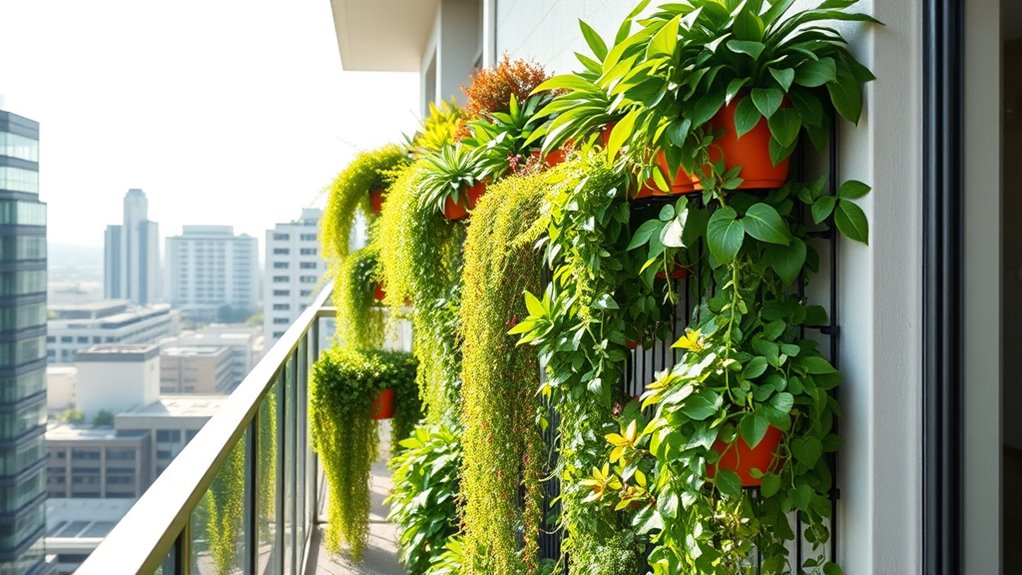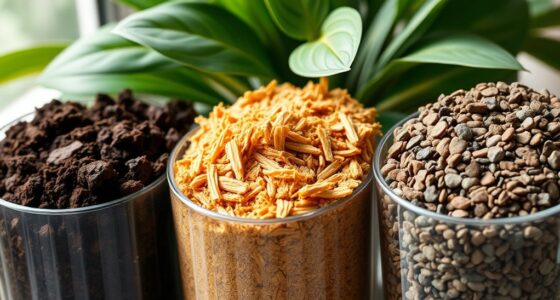Vertical gardening allows you to maximize limited space in small apartments by growing plants on walls or shelves, freeing up valuable floor area. You can easily incorporate herbs, flowers, or foliage using decorative planters or hydroponic systems that are compact and stylish. Arrange plants with varying heights and textures to create a lush, layered effect, making your space feel larger and more vibrant. Keep exploring to discover how to turn your small space into a thriving green oasis effortlessly.
Key Takeaways
- Utilize wall-mounted planters and shelves to create vertical layers and save floor space.
- Incorporate hydroponic systems for soil-free, compact, and low-maintenance indoor gardening.
- Choose decorative, space-efficient planters that complement your apartment’s decor and maximize small areas.
- Arrange plants with varying heights and textures to add depth and visual interest to your vertical garden.
- Start small with simple setups and expand gradually to optimize space without feeling overwhelmed.

Vertical gardening has become a popular way to maximize space and add greenery to even the smallest areas. If your apartment is limited in square footage, this method allows you to enjoy fresh herbs, colorful flowers, and lush foliage without sacrificing precious floor space. One effective approach involves using hydroponic systems, which enable you to grow plants indoors without soil. These systems are compact, easy to maintain, and perfect for small apartments because they fit neatly on walls or shelves. With hydroponics, you can cultivate herbs like basil, mint, and parsley year-round, all while saving space compared to traditional gardening. Additionally, they eliminate mess and reduce pests, making indoor gardening more convenient and accessible.
To enhance the aesthetic appeal of your vertical garden, decorative planters are essential. They come in a wide range of styles, from sleek modern containers to charming vintage pots, allowing you to match your decor. When choosing planters, consider their size, drainage, and material to guarantee your plants thrive. Placing decorative planters on wall-mounted shelves or hanging from hooks creates a dynamic, layered look that draws the eye upward and adds visual interest to your apartment. Combine different shapes and colors to create a vibrant display that reflects your personality. Remember, the right planters not only support healthy plant growth but also serve as design elements, turning your vertical garden into a true focal point.
Now, think about how to arrange your vertical garden for maximum impact. Use a mix of plants with varying heights, textures, and colors to create depth and visual diversity. Position taller plants at the top or center, with trailing or smaller plants cascading downward. This not only looks appealing but also ensures your plants receive appropriate light exposure. If you’re using hydroponic systems, install them at eye level for easy access, and consider mounting them on a sturdy wall or frame that can support the weight. Regularly check water levels and nutrients, as these systems require less attention than traditional soil but still need consistent care to keep your plants healthy.
Incorporating vertical gardening into your apartment doesn’t have to be complicated or expensive. Start small with a few decorative planters or a simple hydroponic setup, then expand as you gain confidence. With thoughtful placement, quality planters, and the innovative use of hydroponic systems, you can transform even a tiny space into a lush, inviting oasis. Not only will you enjoy the beauty and freshness of your plants, but you’ll also make the most of every inch of your living area, turning your apartment into a green sanctuary.
Frequently Asked Questions
How Do I Choose the Best Plants for Vertical Gardens?
To choose the best plants for your vertical garden, start with plant selection based on your space and climate. Consider lighting needs—some plants thrive in bright, direct sunlight, while others prefer low light. Opt for lightweight, easy-to-maintain varieties like succulents or ferns that suit your environment. Make sure to match each plant’s requirements with your apartment’s light conditions to guarantee healthy growth and a thriving vertical garden.
What Are the Common Pests in Vertical Gardening?
Think of pests as uninvited guests crashing your garden party. Common pests include aphids, spider mites, and whiteflies. To keep them at bay, practice pest prevention by regularly inspecting plants and removing debris. Use natural remedies like neem oil or insecticidal soap instead of harsh chemicals. Staying proactive guarantees your vertical garden stays healthy, vibrant, and free of pests, so your plants thrive beautifully in your small space.
How Often Should I Water My Vertical Garden?
You should water your vertical garden every 2-3 days, depending on the plant hydration needs and your home’s humidity. Keep an eye on the soil moisture; if it feels dry a few inches down, it’s time to water. A consistent watering schedule helps prevent overwatering or underwatering, ensuring your plants stay healthy and vibrant. Adjust frequency based on weather, plant type, and container drainage.
Can Vertical Gardens Be Installed Outdoors?
Yes, you can install vertical gardens outdoors. Just remember, outdoor plant maintenance requires weatherproofing vertical gardens to protect against rain, wind, and sun. Use weather-resistant materials, and guarantee your plants are suitable for outdoor conditions. Regularly check for damage or wear, and adjust watering schedules based on weather changes. Proper weatherproofing helps your outdoor vertical garden thrive, making it a beautiful, sustainable addition to your outdoor space.
What Materials Are Safest for Indoor Vertical Gardening?
For safe indoor vertical gardening, choose non-toxic materials like food-grade plastics, untreated wood, or ceramic pots. Prioritize soil safety by using organic, chemical-free potting mixes that won’t harm your plants or indoor air quality. Avoid materials with paints, sealants, or chemicals that could release toxins. Always research and select eco-friendly, non-toxic options to guarantee your indoor garden remains healthy and safe for your household.
Conclusion
Imagine turning your tiny apartment into a lush jungle, with walls bursting with vibrant greenery and every inch alive with nature’s magic. Vertical gardening transforms your space into a thriving oasis where plants seem to grow faster than your dreams. Soon, your walls will breathe and sing, making your apartment the envy of every skyscraper in the city. Embrace this green revolution, and watch your small space become the biggest, most breathtaking garden you’ve ever seen!









